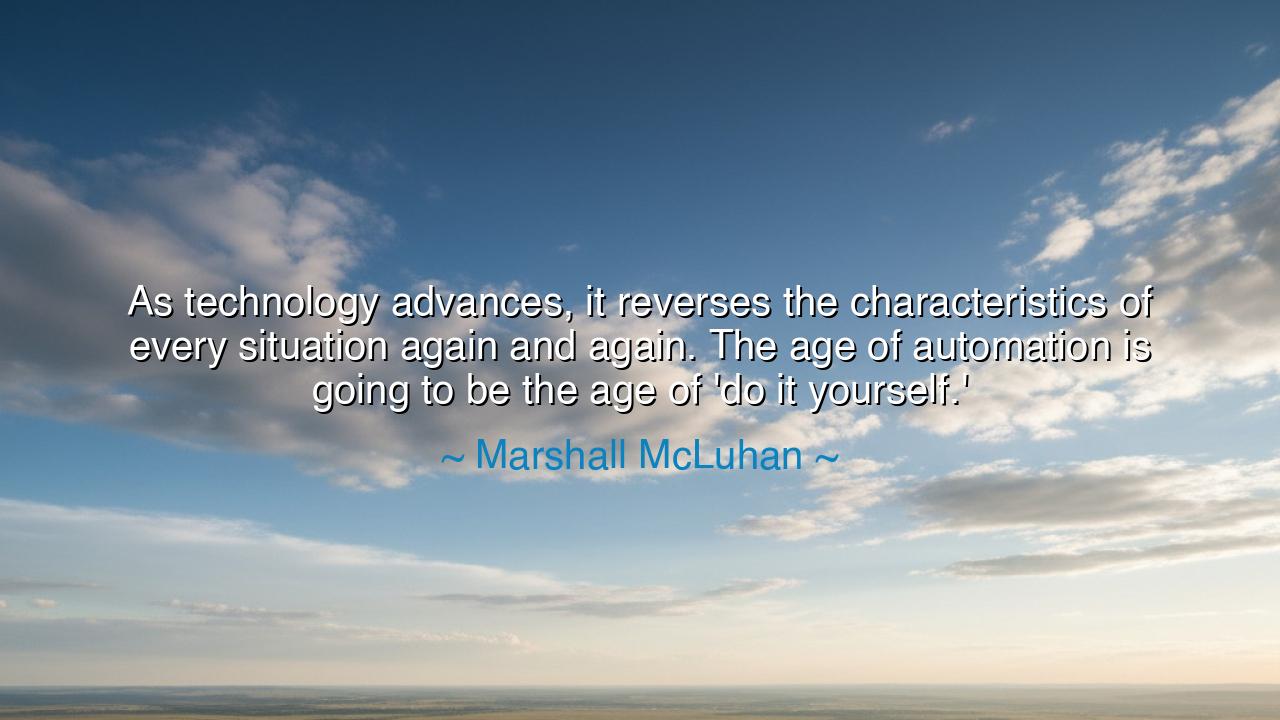
As technology advances, it reverses the characteristics of every
As technology advances, it reverses the characteristics of every situation again and again. The age of automation is going to be the age of 'do it yourself.'






In the ever-turning wheel of history, we have witnessed many profound changes in the way humanity lives, works, and interacts with the world. And yet, one truth remains constant: as the hands of time move forward, so too does the advancement of technology. The great sage of media and communication, Marshall McLuhan, speaks to this relentless evolution when he declares, "As technology advances, it reverses the characteristics of every situation again and again. The age of automation is going to be the age of 'do it yourself.'" This statement, rich with insight, reveals a paradox at the very heart of our technological progress—that the more we create machines to do the work for us, the more we find ourselves called to do the work ourselves in a deeper, more meaningful way.
The ancients understood the duality inherent in progress. The great Greek philosophers, such as Heraclitus, spoke of the eternal flux of the world, where all things are in constant motion and transformation. "You cannot step into the same river twice," Heraclitus said, for the flow of time and change is ever-present, yet ever-changing. Similarly, McLuhan's words capture the spirit of this eternal paradox: as automation makes our lives easier, it simultaneously demands more of our humanity, more of our personal engagement with the world. We are freed from one set of burdens only to be given another, one that requires consciousness, participation, and a return to the self.
Consider the ancient craftsman, who labored for countless hours, carving, molding, and forging objects by hand. Each piece was a reflection of the soul of the maker, a deep expression of their knowledge, their skill, and their labor. As machines arose with the Industrial Revolution, much of this work was automated, freeing the individual from the grind of repetitive labor. Yet, as McLuhan predicts, the very automation that was meant to liberate humanity has led us back to the craft, albeit in a different form. The DIY culture that has flourished in the modern age is a manifestation of this paradox: as machines take over more of our tasks, we, as individuals, are once again called to create, to design, and to personalize our world, not because we must, but because we desire a deeper connection with the work of our hands.
Look at the rise of the internet, the information age, where the masses have access to limitless knowledge and tools at their fingertips. With just a few keystrokes, we can summon information, communicate across vast distances, and automate tasks in ways that were once the stuff of myth. And yet, this very technology has led to an increasing number of people embracing the art of self-reliance—be it through home improvement projects, artisanal crafts, or even coding and entrepreneurship. McLuhan’s insight rings true: the more automated the world becomes, the more we are drawn to the personal, the authentic, and the individual. The automation of tasks paradoxically calls us to engage more deeply with the processes of creation, to find meaning in the work itself.
A powerful example of this can be seen in the rise of the maker movement, a cultural shift that encourages individuals to build, create, and innovate with their own hands, often through the use of 3D printers, laser cutters, and other digital fabrication tools. This movement, which embraces the DIY ethos, is a direct response to the very automation that McLuhan foresaw. In a world where machines can churn out products by the thousands, the desire to create something with one’s own hands, to personalize and innovate on a small scale, has become a profound statement of individual autonomy and empowerment. It is as though, in this age of overwhelming technology, we have rediscovered the ancient art of creation, but in a new, digital form.
And yet, McLuhan’s words urge us to remember that automation itself is a double-edged sword. The more we automate, the less we may understand the intricate workings of the world around us. The ancient builders who constructed the pyramids or the great temples did not have the conveniences of modern technology, yet they understood their craft at the deepest level. They were intimately connected to the material and the process. As we move forward in our age, McLuhan calls us to ensure that in our rush toward the automated world, we do not lose touch with our humanity, our ability to understand the work, to feel the satisfaction of a job well done, and to cultivate the skills that define us.
The lesson here is twofold: first, we must embrace the power and potential of technology but with the wisdom to recognize the value of personal engagement, of the work of our own hands. Second, we must not allow automation to disconnect us from the craftsmanship of life itself. As McLuhan foresaw, the more we automate, the more we will find ourselves drawn to the deep meaning found in the very act of creation—whether it is through art, through building, or through the cultivation of a life filled with purpose and intention.
Therefore, as we advance into this age of automation, let us not lose the essence of what makes us human. Let us use the tools at our disposal to create, to innovate, and to engage in the world not just as passive recipients, but as active participants. The future calls not for disconnection, but for reconnection—with the world around us, with our crafts, and with our own hands. The age of automation, paradoxically, is the age in which we must return to ourselves, to our creativity, and to the power of the individual. Let us create, let us build, let us make.






AAdministratorAdministrator
Welcome, honored guests. Please leave a comment, we will respond soon